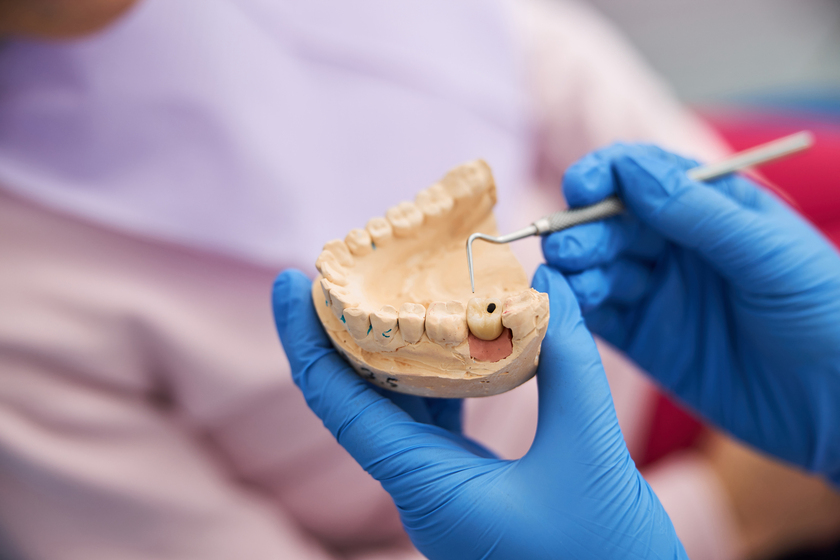Everything you need to know about cavities
¿What are cavities?
The most common causes of cavities are candies, which most of us ignore until they start to hurt. That’s the wrong way to do it, and we’ll explain why. Each tooth in the mouth consists of two main parts: the crown and the root. The crown is the visible part of a tooth while the root is the part that cannot be seen, since it is anchored within the bone.
Within these sections, a tooth is made up of four different types of tissues, which are:
- Enamel: dental enamel is the hardest substance in the body and is responsible for protecting the teeth against the wear of chewing. It is the durable shell that forms the protective outer surface of a tooth’s crown.
- Dentin: Dentin consists of a yellow, bone-like material that makes up most of the inner surface of a tooth. It supports the enamel and also carries some nerve fibers from the teeth.
- Pulp: the term “pulp” is used to define a soft tissue in the center of the tooth that contains blood, nerves and lymphatic vessels.
- Cementum: This tissue covers most of the root of a tooth and helps it adhere to the bones of the jaw.
What does your oral cavity contain?
The oral cavity is the structure inside the mouth that allows you to taste, chew, and swallow food, as well as form words. It consists of two alveolar arches, which support the teeth, and is bordered behind by the isthmus and the fauces. Other parts of the oral cavity include the floor of the mouth, the lips, the mucosa of the neck, the hard palate, and the mobile tongue.
Why do you have tooth decay?
Bacteria normally found in the mouth break down carbohydrates (starch and sugar) into acid. This acid combines with food particles and saliva to form plaque, a sticky substance that sticks to the teeth. Plaque forms after every meal and snack and begins to build up on your teeth 20 minutes after eating.
If not removed, the acid in plaque begins to damage the enamel that covers the teeth and creates holes in the tooth, which are known as cavities or cavities. These are basically permanent structural damage to the outer surface of the teeth that develop into small openings or holes.
A cavity can affect part of a tooth or the whole tooth, depending on how early it is detected and treated. It starts as a white spot, then spreads to enamel, dentin, and cementum, and can even cause an abscess if left untreated, so be sure to include regular dental checkups in your schedule!

Cavity Prevention
In addition to good brushing and flossing habits, the best way to prevent cavities is to treat cavities before they become cavities. Therefore, regular dental checkups are necessary whether or not your mouth feels fine. Through a dental check-up, the first sign of tooth decay (which is indicated by a soft tooth surface) can be detected and treated appropriately.
Other preventive measures that can help prevent cavities include:
- Use of fluorides: Oral fluorides taken in the form of fluoride tablets or fluoridated water are recommended by dentists to protect against cavities. Fluoride helps prevent tooth decay by filling the pores of immature enamel or small early cavities.
- Following a proper diet: Since cavities are caused by sugary, starchy, chewy, and sticky foods, practicing good eating habits can also help prevent cavities. This includes eating fewer foods that cause cavities, as well as avoiding snacking between meals.
- Use of Sealants: Sealants are thin, plastic-like coatings that are applied to the surfaces of molars and premolars to prevent plaque buildup in the deep grooves of these teeth. Sealants are typically applied to young children’s teeth soon after their molars erupt, however they can also be used by adults when prescribed by a dentist.

Cavities Treatment
The ideal treatment for a cavity depends on how extensively it has spread. In general, the less advanced the cavity, the less pain and expense you will have to pay for treatment. Various cavity treatment options that your dentists may suggest include:
- Fillings: For less serious cavities, your dentist may remove the decayed tooth material with a drill and replace it with fillings made of gold, silver, alloy, porcelain, or composite resin. All of these materials are completely safe, but porcelain and composite fillings are preferred as they closely resemble the appearance of natural teeth.
- Root canals: this procedure is necessary or when the nerves of a tooth have died due to decay. The dentist will remove parts of the damaged tooth along with the nerves and blood vessels in the center of the tooth. The roots will be filled with a sealing material and a crown will be placed over the filled tooth.
- Crowns: When a cavity is so severe that minimal tooth structure remains, treatment will be required that includes the placement of a crown (made of porcelain, gold, or porcelain fused to metal). This procedure includes the removal and repair of the entire damaged area followed by the placement of a crown over the remaining portion of the tooth.
Untreated cavities can lead to severe toothaches, painful eating, infections, and eventually tooth loss. The bottom line is that cavities really are no fun at all, so be sure to get immediate dental care.
